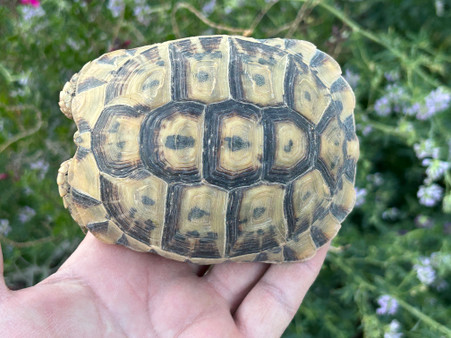- Home
- Tortoises For Sale
- Greek Tortoises For Sale
- Adult Female (Libyan/Tunisian) Greek Tortoise - 1 Available
- Home
- Tortoises For Sale
- Pet Tortoises For Sale - 4" Size or Larger
- Adult Female (Libyan/Tunisian) Greek Tortoise - 1 Available
Adult Female (Libyan/Tunisian) Greek Tortoise - 1 Available
Product Reviews
Description
This is a new locale Greek tortoise that was imported in 2023, and is in the process of being scientifically described. It's from a Tunisia origin imported from Libya. We have been calling these 'Libya Minors,' as the subspecies stays much smaller than a Libyan Greek but has a similar look to a Tunisian greek tortoise. Pictured is the exact tortoise we have available.
Common Name: Greek Tortoise
Scientific Name: Testudo Graeca Spp (undefined subspecies)
Current Size: 5"+/-
Average Adult Size: 4-6" (females larger)
Area of Origin: Libya/Tunisia
Description: Very light sandy tan color with bold black markings on the shell. This is an extremely rare locale of Greek tortoise in the United States. Libyan greeks are thought to tolerate (and prefer) slightly warmer overall temperatures than other locales of greek tortoise. All greeks are somewhat of a high domed tortoise, and most Greek tortoises maintain a "glossy" looking shell through life. As babies, Greek tortoises look very similar to baby Hermanns tortoises.
Habitat: Mediterranean tortoises, these animals live in sandy desert areas where they come and go from their burrows in order to maintain the ideal temperatures. There is some debate whether this type of Greek tortoise hibernates naturally, although it will in captivity and seems to help in the reproduction efforts if they are allowed to hibernate. As adults, they can safely handle body temperatures as low as 35 degrees during hibernation, and on cold spring, summer or fall months, they will retreat underground to maintain some warmth. Summer highs up to 110 degrees can be tolerated as long as there is a cooler, underground retreat the tortoise can get into. In hot climates, they will spend much of the summer days in burrows or simply buried under an inch or two of earth.
Diet: This tortoise is naturally a browser, eating broadleaf weeds and low leaves from bushes and shrubs. In captivity, Greek tortoises will graze on leafy weeds, dandelion, clover, and most other leafy greens provided to them. As babies, we focus more on feeding them a wide mix of leafy greens (spring mix). Vegetables can be added to the diet for variety, but fruit should generally be avoided or given as no more than 5-10% of the diet.
Adult Behavior: Adult Greek tortoises are active, busy tortoises when the temperatures are in their ideal ranges (60-90 degrees). They are un-aggressive towards eachother in most cases, and can be kept in small groups. The mating habits can create some problems as sometimes will ram at each other to establish dominance through the ranks. Most will eagerly come to their keepers looking for food once they are comfortable in their environments. They can be good climbers and will make attempts to escape, so perimeter fences should be buried at least 6-12" underground, and sidewalls 12-16" above ground will normally contain them.
Our Current Care: These tortoises are kept outdoors all year here in Las Vegas NV (high and low temps ranging from 25 to 120 degrees).
 Loading... Please wait...
Loading... Please wait...

